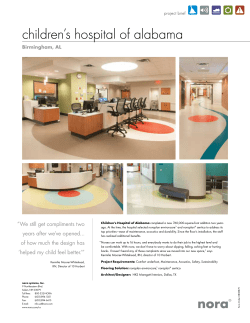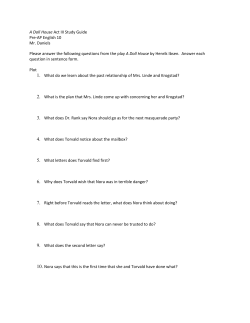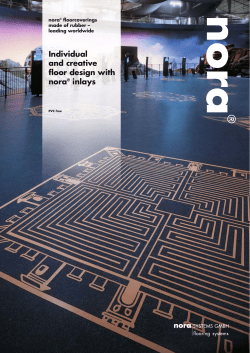
Typical mistakes when joint-sealing nora rubber floor
Typical mistakes when joint-sealing nora® rubber floor coverings and how to avoid them nora® rubber floor coverings do not contain any plasticizers as do e.g. PVC floor coverings. These may thus not drift and result in shrinking floor coverings. nora® rubber floor coverings are thus extremely dimensionally stable when bonded and meet the standard EN 434 “Determination of dimensional stability after exposure to heat" without any problems. Because of these specific properties, the subsequent joint-sealing of tiles and rolls is not necessary. Compared to other resilient floor covering materials, such as e.g. PVC and linoleum, several advantages result from this: An attractive visual impression is created thanks to the uniform surface, without any irritating seams. There are no easily soiling joints. Cost benefits result from the savings in time, wages and material. Figure 1: Surface without joint-sealing Usual cleaning methods such as e.g. by single-disc machines, cleaning machines or wet mopping can, of course, also be used with complete confidence for surfaces without joint-sealing. Joint-sealing is solely required in a few special application areas. Because of hygiene requirements, as e.g. those existing in hospitals, the hygiene officers often request a joint-sealing. We also recommend joint-sealing in areas where water remains on the floor for a longer period of time (nautical cleaning). Our acoustic floor coverings are a further exception. Seams must be closed here because of their high resilience. The same applies to our ed floor coverings. If a joint-sealing is made for the above mentioned reasons or if this is requested project-specifically, various mistakes may occur when using nora® hot-welding rod or joint sealing compound. 1 This article is to exemplify typical mistakes when joint-sealing nora® rubber floor coverings and to show how to avoid them. A. Joint-sealing with hot-welding rod: In practice, joint connections using hot-welding rod is the method most commonly used for all resilient floor coverings - this is also true for rubber floor coverings. Joint-sealing should be made 24 hours after bonding of the floor covering at the earliest. What has to be observed or which mistakes can be made in this respect? 1. Premature evaluation of the adhesion of the hot-welding rod: From time to time we receive phone calls complaining about lacking adhesion of the hot-welding rod. Contrary to PVC, linoleum and rubber floor coverings are thermobonded with the hot-welding rod which can be removed from the milled joint after fitting and immediate racking. Figure 2: Hot-welding rod removed when still hot The protruding part may thus only be cut off after cooling down in two work steps with a Saddler’s knife ground to a sharp edge using a weld spatula guide. 2. Wrong temperature and speed: The right processing temperature, which ranges between 350 – 400°C, has an important influence on the adhesion and proper processing. 2 Figure 3: The correct processing temperature ranges between 350 - 400°C The hot-welding rod is fitted using either the hand-operated hot welding gun or a welding machine. The correct operating temperature is reached when the hotwelding rod wells out slightly on the left-hand and right-hand edges of the joint. It is also to be noted that the welding speed is lower compared with linoleum or PVC floor coverings. If the processing temperature is too high, discolourations inevitably occur as shown by the following image: Figure 4: Discolourations caused by excessive processing temperature For detailed work instructions, please visit our installation recommendations on our Website www.nora.com 3. Damages caused by non-sharp trimming knife Unfortunately, blunt trimming knives are frequently used to cut the protruding part. The following images show a Saddler’s knife how it should not look and the resulting scratches: 3 Figure 5: Blunt trimming knife … . Figure 6: … and the resulting scratches The aforesaid damages to the floor covering surface may normally be well-hidden by using a wax-containing care product. nora® liquid wax has also proven itself as quick solution for such cases. Any occurring differing brilliance levels are correspondingly compensated for during the routine cleanings. 4. Removal of protrusions As the following figure shows, slight protrusions of the hot-welding rod cannot be removed entirely by cutting. The floor covering surface is inevitably damaged. 4 Figure 7: Damages when removing protruding hot-welding rod In such cases, melting off of the protruding part using a non-sharpened spatula which is heated up by means of the hand-operated hot welding gun and run along the joint has proven itself as suitable method. The protruding part of the hotwelding rod can thus be easily levelled. 5. Joint-sealing of noraplan® acoustic floor coverings The joint-sealing of noraplan® acoustic floor coverings may present a certain challenge to untrained persons. This is because the hot-welding rod only protrudes insufficiently because of the resilience of the material to make a clean second cut. We thus recommend fixing two or three layers of self-adhesive copper tape under the weld spatula guide so that there remains sufficient material after the first cut for a clean second cut. Figure 8: Weld spatula guide with affixed self-adhesive copper tape 5 Figure 9: Sufficient protrusion for a second clean cut B. Joint-sealing with nora® joint sealing compound: If a norament® floor covering must be joint-sealed, the use of nora® joint-sealing compound has proven itself already for many years. The joint-sealing compound must also be used to close the seams between the floor covering level and a wall covering. The same applies in this connection to external and internal corners and joint-sealings of floor coverings at skirtings with a broad base. 1. Waxing of the floor covering joints to be joint-sealed The seam area is to be sufficiently waxed with nora® liquid wax to be able to subsequently remove the protrusions easily from the floor covering surface. Otherwise, the joint-sealing compound may adhere to the surface and can only be removed using greatest efforts - if at all. Figure 10: Waxed seam area 6 Figure 11: Milled, waxed joint In this connection it must be noted that no joint wax may penetrate the joints because otherwise the joint-sealing compound may come off. Should joint wax penetrate the joints, the joints must be reworked with the joint cutter. 2. Wrong position of the spatula The protrusions of the joint-sealing compound are pressed into the joint with a spatula directly after fitting, running the spatula even over the joint. The excessive joint-sealing compound is pressed to the left and right of the joint. The joint-sealing compound in the joint must be separated from the material pressed to the side. Figure 12: Correct, flat position of the spatula The next figures show such a joint with groove. In the course of use, collection of dirt will result in a visually unattractive joint and complaints are certainly to be expected. 7 Figures 13+14: An excessively steep, almost vertical position inevitably results in grooves 3. Missing cordoning off / discolourations by joint-sealing compound Unfortunately, it often happens that the area sealed with the joint-sealing compound is not cordoned off until the compound has been fully hardened or premature walking on the surface may result in discolourations by the joint-sealing compound, as shown by the following images: 8 Figures 15+16: Discolourations caused by joint-sealing compound The joint-sealing compound takes 12 hours to harden. During this time, the joints may not be walked on. If joint-sealing compound is spilled on non-waxed areas, it must be immediately removed – our nora® liquid wax has also proven worthwhile for emergency cases in this respect. For detailed recommendations in connection with the joint-sealing of nora® floor coverings, please visit installation recommendations / sealing on our Website www.nora.com 9
© Copyright 2025













